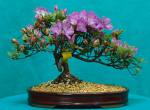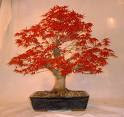Welcome to THE BONSAI TREE SITE. Bonsai is a tradition that dates back thousands of years. There are actual pictorial records from around 4000 BC in the early times of Egyptian culture that show trees growing in containers cut into rock. In India, container-grown trees were used for medicine and food. The Japanese popularized container-grown trees during China's Song Dynasty, between 960 and 1279. The word bonsai comes from two words, 'Bon' and 'Sai'. 'Bon' means tray and 'Sai' means growing or planting. In Japanese, bonsai can be translated as 'tray planting'. Here at THE BONSAI TREE SITE you will learn the art of growing aesthetic miniature trees and other plants shaped as trees.
Bonsai's are unique and beautiful little trees made to look aged and are very relaxing to look at especially when a waterfall is set near the tree or in its environment.
Growing bonsai trees is an art. It is the art of dwarfing trees or plants and shaping them into appealing and interesting forms. This is done by growing, pruning and training them in special attractive containers that artistically become one with the tree.
You can grow outdoor bonsai trees or indoor bonsai trees from seeds or cuttings, from young trees or from natural stunted trees transplanted into containers. To keep these trees small it is necessary to prune branches and roots, by wiring the trunk and branches so that they grow in the shape you want them to grow. It is also necessary to repot periodically and pinch off new growth.
You don't have to worry too much about abusing the tree and roots. It doesn't hurt the tree to cut the roots and trim the branches. You can take a part of a growing plant and cut it off and place in a growing medium to grow roots. If the part you cut off is fairly thick it can be grown to an aged look however the thinner and younger cuttings tend to grow roots more redily.
You can also layer rooting by encouraging roots to grow from part of a plant which is usually a branch of the parent plant. Once the rooting takes place, remove the branch from the parent and grow separately. Rooting is encouraged close to the side branches, so the rooted tree can have a thick trunk and low branches from the start. This complements the look and aesthetics of a bonsai tree. This technique is called 'layering'.
The materials and tools needed for starting or repotting your own bonsai tree is:
- Copper or aluminium wire used to wire around branches and trunks to create the desired form and make detailed leaf and branch placements.
- Pruning shears for pruning the trunk, branches, and roots. you need medium duty and heavy Bonsai Tools & Wire
- Concave cutters which are necessary to style bonsai. The whole point is to uniqly style your own bonsai tree.
- Wire cutters used to cut the wires used to shape your bonsai. There are specialized wire cutters especially for bonsai to reduce damage to your bonsai tree. Bonsai Tools & Wire
- Jin and Wire pliers are used to stripe bark and fiber from your bonsai to encourage the aging effect by lightning and weather.
- Rakes and tweezers is a combination tool. This tool is very effective for loosening soil or combing out tangled roots while repotting. You can use the tweezers for removing dead leaves and other fine debris.
- Bonsai watering tools help you to make sure your bonsai tree is getting the right amount of water.
- Bonsai Soil and potting mix are special bonsai soil which offers exactly the right balance of nutrients for your little tree. There are many different kinds so make sure you get the correct one for your type of bonsai tree. It is important to have the correct soil for bonsai trees. Bonsai soils are loose and gravelly. You can purchase bonsai soil from various plant shops. DO NOT USE regular potting soil. Bonsai Soils
- Of course you need a bonsai pot to contain the tree. Bonsai Pots
- Books for the beginner and for the experienced professional. Click here
books can help the beginner and the professional since there are tips, tricks, and proven techniques to give you a better understanding of the art of bonsai.
Just to let you know, you can purchase artificial bonsai trees that look authentic but it would be much more interesting and fun to grow and shape your own. But if you don't feel like going through the trouble (and that depends on the person) then you can purchase a real looking artificial bonsai tree. Artificial Bonsai Trees

Thank you for visiting my bonsai blog.



